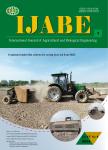Identification of tomato leaf diseases using convolutional neural network with multi-scale and feature reuse
作者机构:College of EngineeringSouth China Agricultural UniversityGuangzhou 510642China Agricultural Economy and Information Research InstituteAnhui Academy of Agricultural SciencesHefei 230031China
出 版 物:《International Journal of Agricultural and Biological Engineering》 (国际农业与生物工程学报(英文))
年 卷 期:2023年第16卷第6期
页 面:226-235页
核心收录:
学科分类:0828[工学-农业工程] 09[农学] 0902[农学-园艺学] 090202[农学-蔬菜学]
基 金:supported by the China Agriculture Research System (CARS-170404) Qingyuan Science and Technology Plan (Grant No.2022KJJH063) Guangzhou Science and Technology Plan (Grant No.201903010063).
主 题:tomato diseases convolutional neural network confusion matrix multi-scale feature reuse
摘 要:Various diseases seriously affect the quality and yield of tomatoes. Fast and accurate identification of disease types is of great significance for the development of smart agriculture. Many Convolution Neural Network (CNN) models have been applied to the identification of tomato leaf diseases and achieved good results. However, some of these are executed at the cost of large calculation time and huge storage space. This study proposed a lightweight CNN model named MFRCNN, which is established by the multi-scale and feature reuse structure rather than simply stacking convolution layer by layer. To examine the model performances, two types of tomato leaf disease datasets were collected. One is the laboratory-based dataset, including one healthy and nine diseases, and the other is the field-based dataset, including five kinds of diseases. Afterward, the proposed MFRCNN and some popular CNN models (AlexNet, SqueezeNet, VGG16, ResNet18, and GoogLeNet) were tested on the two datasets. The results showed that compared to traditional models, the MFRCNN achieved the optimal performance, with an accuracy of 99.01% and 98.75% in laboratory and field datasets, respectively. The MFRCNN not only had the highest accuracy but also had relatively less computing time and few training parameters. Especially in terms of storage space, the MFRCNN model only needs 2.7 MB of space. Therefore, this work provides a novel solution for plant disease diagnosis, which is of great importance for the development of plant disease diagnosis systems on low-performance terminals.



